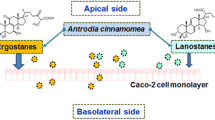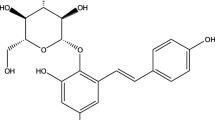Abstract
Background
Lychnophora trichocarpha (Spreng.) Spreng. ex Sch.Bip has been used in folk medicine to treat pain, inflammation, rheumatism and bruises. Eremantholide C, a sesquiterpene lactone, is one of the substances responsible for the anti-inflammatory and anti-hyperuricemic effects of L. trichocarpha.
Objectives
Considering the potential to become a drug for the treatment of inflammation and gouty arthritis, this study evaluated the permeability of eremantholide C using in situ intestinal perfusion in rats. From the permeability data, it was possible to predict the fraction absorbed of eremantholide C in humans and elucidate its oral absorption process.
Methods
In situ intestinal perfusion studies were performed in the complete small intestine of rats using different concentrations of eremantholide C: 960 μg/ml, 96 μg/ml and 9.6 μg/ml (with and without sodium azide), in order to verify the lack of dependence on the measured permeability as a function of the substance concentration in the perfusion solutions.
Results
Eremantholide C showed Peff values, in rats, greater than 5 × 10−5 cm/s and fraction absorbed predicted for humans greater than 85%. These results indicated the high permeability for eremantholide C. Moreover, its permeation process occurs only by passive route, because there were no statistically significant differences between the Peff values for eremantholide C.
Conclusion
The high permeability, in addition to the low solubility, indicated that eremantholide C is a biologically active substance BCS class II. The pharmacological activities, low toxicity and biopharmaceutics parameters demonstrate that eremantholide C has the necessary requirements for the development of a drug product, to be administered orally, with action on inflammation, hyperuricemia and gout.
Graphical abstract




Similar content being viewed by others
References
Azevedo VF, Lopes MP, Catholino NM, Paiva ES, Araújo VA, Pinheiro GRC. Revisão crítica do tratamento medicamentoso da gota no Brasil. Rev Bras Reumatol. 2017;57(4):346–55.
Pillinger MH, Mandell BF. Therapeutic approaches in the treatment of gout. Semin Arthritis Rheum. 2020;50:S24–30.
Cerqueira MBS, Souza JT, Júnior RA, Peixoto ABF. Ação analgésica do extrato bruto aquoso liofilizado do caule e folhas de Lychnophora ericoides Mart. Ciênc Cult. 1987;39(5/6):551–3.
Saúde DA, Raslan DS, Souza Filho JD, Oliveira AB. Constituents from the aerial parts of Lychnophora trichocarpha. Fitoterapia. 1998;69:90–1.
Chaves TL, Ricardo L, Paula-Souza J, Brandão MGL. Useful brazilian plants under the view of the writer-naturalist João Guimarães Rosa. Rev Bras Farmacogn. 2015;25:437–44.
Souza MR, de Paula CA, Rezende MLP, Grabe-Guimarães A, de Souza Filho JD, Saúde-Guimarães DA. Pharmacological basis for use of Lychnophora trichocarpha in gouty arthritis: anti-hyperuricemic and anti-inflammatory effects of its extract, fraction and constituents. J Ethnopharmacol. 2012;142:845–50.
Ferrari FC, Ferreira LC, Souza MR, Grabe-Guimarães A, Paula CA, Rezende SA, et al. Anti-inflammatory sesquiterpene lactones from Lychnophora trichocarpha Spreng. (Brazilian arnica). Phytother Res. 2013;27(3):384–9.
Bernardes ACFPF, Coelho GB, Araújo MCPM, Saúde-Guimarães DA. In vivo anti-hyperuricemic activity of sesquiterpene lactones from Lychnophora species. Rev Bras Farmacogn. 2019;29:241–5.
Löbenberg R, Amidon GL. Modern bioavailability, bioequivalence and biopharmaceutics classification system. New scientific approaches to international regulatory standards. Eur J Pharm Biopharm. 2000;50:3–12.
Amidon GL, Lennernäs H, Shah VP, Crison JR. A theoretical basis for a biopharmaceutic drug classification: the correlation of in vitro drug product dissolution and in vivo bioavailability. Pharm Res. 1995;12(3):413–20.
European Medicines Agency. Guideline on the investigations of bioequivalence. 2010. http://www.ema.europa.eu/docs/en_GB/document_library/Scientific_guideline/2010/01/WC500070039.pdf Accessed 01 Nov 2020.
World Health Organization. WHO Expert Committee on Specifications for Pharmaceutical Preparations. 2015. http://apps.who.int/iris/bitstream/10665/81144/1/WHO_TRS_981_eng.pdf Accessed 01 Nov 2020.
Food and Drug Administration. Waiver of in vivo bioavailability and bioequivalence studies for immediate-release solid oral dosage forms base on a Biopharmaceutics Classification System. 2017. https://www.fda.gov/downloads/Drugs/Guidances/ucm070246.pdf Accessed 01 Nov 2020.
Cao X, Gibbs ST, Fang L, Miller HA, Landowski CP, Shin HC, et al. Why is it challenging to predict intestinal drug absorption and oral bioavailability in human using rat model. Pharm Res. 2006;23(8):1675–85.
Lennernäs H. Regional intestinal drug permeation: biopharmaceutics and drug development. Eur J Pharm Sci. 2014;57:331–41.
Lozoya-Agullo I, Zur M, Wolk O, Beig A, González-Álvarez I, González-Álvarez M, et al. In-situ intestinal rat perfusions for human Fabs prediction and BCS permeability class determination: investigation of the single-pass vs. the Doluisio experimental approaches. Int J Pharm. 2015;480:1–7.
Liu JY, Lee KF, Sze CW, Tong Y, Tang SCW, Ng TB, et al. Intestinal absorption and bioavailability of traditional Chinese medicines: a review of recent experimental progress and implication for quality control. J Pharm Pharmacol. 2012;65:621–33.
Waldmann S, Almukainzi M, Bou-Chacra NA, Amidon GL, Lee BJ, Feng J, et al. Provisional biopharmaceutical classification of some common herbs used in western medicine. Mol Pharm. 2012;9:815–22.
Volpe DA. Application of method suitability for drug permeability classification. AAPS J. 2010;12(4):670–8.
Dezani TM, Dezani AB, Silva MMC, Serra CHR. In situ intestinal perfusion in rodents: future perspectives for application on absorption studies and classification of drugs. Mini Rev Med Chem. 2017;17:746–57.
Caldeira TG, Saúde-Guimarães DA, Dezani AB, Serra CHR, Souza J. In silico and in vitro prediction of gastrointestinal absorption from potential drug eremantholide C. J Pharm Pharmacol. 2017;69:1468–76.
Caldeira TG, Saúde-Guimarães DA, Lacerda DLR, Mussel WN, Yoshida MI, Souza J. Polymorphic characterization and implications on biopharmaceutics properties of potential anti-inflammatory drug candidate eremantholide C from Lychnophora trichocarpha (Brazilian Arnica). J Pharm Pharmacol. 2019;71:910–9.
Le Quesne PW, Levery SB, Menachery MD, Brennan TF, Raffauf RF. Novel modified germacranolides and other constituents of Eremanthus elaegnus Achultz-Bip. (Compositae). J Chem Soc, Perkin Trans I. 1978;12:1572–80.
Saúde-Guimarães DA, Perry KS, Raslan DS, Chiari E, Barrero AF, Oltra JE. Complete assignments of 1H and 13C NMR data for trypanocidal eremantholide C oxide derivatives. Magn Reson Chem. 2007;45:1084–7.
United States Pharmacopeia, 37 ed. Rockville: The United States Pharmacopeial Convention; 2014.
Muñoz MJ, Merino-Sanjuán M, Llegó-García R, Casabó VG, Máñez-Castillejo FJ, Nácher A. Use of nonlinear mixed effect modeling for the intestinal absorption data: application to ritonavir in the rat. Eur J Pharm Biopharm. 2005;61:20–6.
Venkatesh G, Ramanathan S, Nair NK, Mansor SM, Sattar MA, Khan MAH, et al. Permeability of atenolol and propranolol in the presence of dimethyl sulfoxide in rat single-pass intestinal perfusion assay with liquid chromatography/UV detection. Biomed Chromatogr. 2007;21:484–90.
Doluisio JT, Billups NF, Dittert LW, Sugita ET, Swintosky JV. Drug absorption I: an in situ rat gut technique yielding realistic absorption rates. J Pharm Sci. 1969;58(10):1196–200.
Caldeira TG, Ruiz-Picazo A, Lozoya-Agullo I, Saúde-Guimarães DA, González-Álvarez M, Souza J, et al. Determination of intestinal permeability using in situ perfusion model in rats: challenges and advantages to BCS classification applied to digoxin. Int J Pharm. 2018;551:148–57.
Monteiro PF, Silva-Barcellos NM, Caldeira TG, Reis ACC, Ribeiro AS, Souza J. Effects of experimental conditions on solubility measurements for BCS classification in order to improve the biowaiver guidelines. Braz J Pharm Sci. 2019. In press.
Martin-Villodre A, Delfina JMP, Moreno J, Perez-Buendia D, Miralles J, Cohado EF, et al. Studies on the reliability of a bihyperbolic functional absorption model. I. Ring-substituted anilines. J Pharmacokinet Biopharm. 1986;14(6):615–33.
Tugcu-Demiroz F, González-Álvarez I, González-Álvarez M, Bermejo M. Validation of phenol red versus gravimetric method for water reabsorption correction and study of gender differences in Doluisio's absorption technique. Eur J Pharm Sci. 2014;62:105–10.
Fagerholm U, Johansson M, Lennernäs H. Comparison between permeability coefficients in rat and human jejunum. Pharm Res. 1996;13(9):1336–42.
Dezani TM, Dezani AB, Silva Junior JB, Serra CHR. Single-pass intestinal perfusion (SPIP) and prediction of fraction absorbed and permeability in humans: a study with antiretroviral drugs. Eur J Pharm Biopharm. 2016;104:131–9.
Sánchez-Castaño G, Ruíz-Garcia A, Bañon N, Bermejo M, Merino V, Freixas J, et al. Intrinsic absolute bioavailability prediction in rats based on in situ absorption rate constants and/or in vitro partition coefficients: 6-fluoroquinolones. J Pharm Sci. 2000;89(11):1395–403.
Zakeri-Milani P, Valizadeh H, Tajerzadeh H, Azarmi Y, Islambolchilar Z, Barzegar S, et al. Predicting human intestinal permeability using single-pass intestinal perfusion in rat. J Pharm Pharm Sci. 2007;10(3):368–79.
Kansy M, Senner F, Gubernator K. Physicochemical high throughput screening: parallel artificial membrane permeation assay in the description of passive absorption processes. J Med Chem. 1998;41(7):1007–10.
Yang H, Zhai B, Fan Y, Wang J, Sun J, Shi Y, et al. Intestinal absorption mechanisms of araloside a in situ single-pass intestinal perfusion and in vitro Caco-2 cell model. Biomed Pharmacother. 2018;106:1563–9.
Dubbelboer IR, Dahlgren D, Lennernäs H. Rat intestinal drug permeability: a status report and summary of repeated determinations. Eur J Pharm Biopharm. 2019;142:364–76.
Gai MN, Campos DR, Storpirtis S, Gonçalves JE. Farmacocinética Não Linear. In: Storpirtis S, Gai MN, Campos DR, Gonçalves JE, editors. Farmacocinética Básica e Aplicada. Rio de Janeiro: Guanabara Koogan; 2011. p. 75–81.
Valenzuela B, Nácher A, Casabó VG, Martín-Villodre A. The infuence of active secretion processes on intestinal absorption of salbutamol in the rat. Eur J Pharm Biopharm. 2001;52:31–7.
Fernandez-Teruel C, González-Álvarez I, Casabó VG, Ruiz-Garcia A, Bermejo M. Kinetic modelling of the intestinal transport of sarafloxacin. Studies in situ in rat and in vitro in Caco-2 cells. J Drug Target. 2005;13(3):199–212.
Amidon GE, Ho NFH, French AB, Higuchi WI. Predicted absorption rates with simultaneous bulk fluid flow in the intestinal tract. J Theor Biol. 1981;89:195–210.
Zakeri-Milani P, Barzegar-Jalali M, Azimi M, Valizadeh H. Biopharmaceutical classification of drugs using intrinsic dissolution rate (IDR) and rat intestinal permeability. Eur J Pharm Biopharm. 2009;73:102–6.
Kawabata Y, Wada K, Nakatani M, Yamada S, Onoue S. Formulation design for poorly water-soluble drugs based on biopharmaceutics classification system: basic approaches and practical applications. Int J Pharm. 2011;420:1–10.
Kumar S, Bhargava D, Thakkar A, Arora S. Drug carrier systems for solubility enhancement of BCS class II drugs: a critical review. Crit Rev Ther Drug Carrier Syst. 2013;30(3):217–56.
Estudante M, Morais JG, Soveral G, Benet LZ. Intestinal drug transporters: an overview. Adv Drug Deliv Rev. 2013;65:1340–56.
Wu CY, Benet LZ. Predicting drug disposition via application of BCS: transport/absorption/elimination interplay and development of a biopharmaceutics drug disposition classification system. Pharm Res. 2005;22(1):11–23.
Wu Q, Zhao B, Yang XW, Xu W, Zhang P, Zou L, et al. Intestinal permeability of sesquiterpenes in the Caco-2 cell monolayer model. Planta Med. 2010;76:319–24.
Xu R, Peng Y, Wang M, Li X. Intestinal absorption of isoalantolactone and alantolactone, two sesquiterpene lactones from Radix Inulae, using Caco-2 cells. Eur J Drug Metab Pharmacokinet. 2019;44:295–303.
Acknowledgments
The authors would like to thank Fundação de Amparo à Pesquisa do Estado de Minas Gerais (FAPEMIG), Coordenação de Aperfeiçoamento de Pessoal de Nível Superior (CAPES), Conselho Nacional de Desenvolvimento Científico e Tecnológico (CNPq), Agência Nacional de Vigilância Sanitária (Anvisa) companies and Universidade Federal de Ouro Preto (Auxílio Pesquisador/PROPP/UFOP 2018 and 2019) for financial support. In addition, the authors would like to acknowledge Drª Daniela Caldeira Costa (CBIOL/NUPEB/UFOP), for donating the sodium azide, Brazilian Pharmacopeia/Fiocruz/INCQS for providing the standard drugs and Laboratório Multisusuário (CiPharma/UFOP) for providing the HPLC system. This study was financed in part by the Coordenação de Aperfeiçoamento de Pessoal de Nível Superior - Brasil (CAPES) - Finance Code 001.
Author information
Authors and Affiliations
Contributions
Tamires Guedes Caldeira performed the experiments and wrote the manuscript. Dênia Antunes Saúde-Guimarães supervised and guided some experimental activities and revised the manuscript. Isabel González-Álvarez and Marival Bermejo helped in the calculation and treatment of experimental data and gave suggestions on the revision of the manuscript. Jacqueline de Souza coordinated, supervised and guided the experimental activities and revised and gave suggestions on the revision of the manuscript. The manuscript has been read and approved by all authors.
Corresponding author
Ethics declarations
Conflict of interest
The authors declare no conflict of interest.
Ethics approval
The experimental protocol was approved by ethics committee (Comitê de Ética no Uso de Animais - CEUA) of Universidade Federal de Ouro Preto under protocol number 2018/07. The animals were supplied by the Centro de Ciência Animal (CCA) of Universidade Federal de Ouro Preto and used, in studies, according to all the guidelines established by the Conselho Nacional de Controle de Experimentação Animal (CONCEA).
Additional information
Publisher’s note
Springer Nature remains neutral with regard to jurisdictional claims in published maps and institutional affiliations.
Rights and permissions
About this article
Cite this article
Caldeira, T.G., Saúde-Guimarães, D.A., González-Álvarez, I. et al. Eremantholide C from aerial parts of Lychnophora trichocarpha, as drug candidate: fraction absorbed prediction in humans and BCS permeability class determination. DARU J Pharm Sci 29, 195–203 (2021). https://doi.org/10.1007/s40199-021-00397-6
Received:
Accepted:
Published:
Issue Date:
DOI: https://doi.org/10.1007/s40199-021-00397-6




